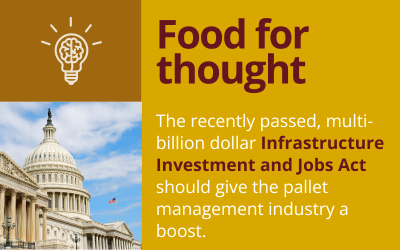
There’s been lots of debate over the years about so-called “trickle-down economics,” which typically refers to the idea (or hope) that tax-savings realized by wealthy individuals or private sector businesses will eventually find their way down to the lower end of the economic ladder. But the same concept might be applied to major government investment initiatives – like spending on promotion of green technology or efforts to bring the semiconductor back to the U.S.
Does spending on such broad objectives and strategies really ‘trickle down’ to micro-segments of a particular industry?
Ongweoweh expects that will be the case with the bi-partisan Infrastructure Investment and Jobs Act, passed by Congress on November 5, 2021, and signed into law on November 15, 2021. This law allocates approximately $1.2 trillion to improve the U.S. infrastructure, including transportation, broadband, and utilities. And, more specifically, it allocates $550 billion in new Federal spending over five years for transportation – including $110 billion for roads and bridges, $66 billion for rail, and $17 billion for ports and waterways.
In our view, this effort should have a significant positive impact on various sectors, including shipping, logistics, and materials handling. Let’s look at how this legislation could benefit these sectors, and even touch on possible impacts it will have on the wooden pallet manufacturing and distribution business.
Improved Over-the-Road Transportation Infrastructure
As stated at the outset, the Act allocates substantial funding for the improvement and modernization of transportation infrastructure, including roads and bridges. For the shipping and logistics sector, that should eventually translate to reduced transit and delivery times for customers of all kinds (e.g., manufacturers, retailers, and end-users). Improved infrastructure also has the potential to lower transportation costs by reducing vehicle wear and tear and fuel consumption. And, finally, improved infrastructure should lead to more reliable shipping schedules, reducing delays and uncertainties in the supply chain.
For the wooden pallet industry, which relies heavily on trucking for distribution, these improvements mean pallets should be transported more quickly and reliably, reducing downtime and increasing the efficiency of supply chains.
Enhanced Rail and Port Facilities
Investments in rail and port facilities will likewise bolster the intermodal transportation network – facilitating smoother transitions between different modes of transport (e.g., from ship to rail to truck), boosting capacity, and introducing technologies (like automation and analytics) that help that increase efficiency reducing bottlenecks and improving throughput.
Here again, wooden pallets manufacturers, distributors, brokers, and users should benefit from reduced handling times and lower risk of damage during transitions, ensuring goods arrive in better condition.
Technological Advancements and Modernization
Speaking of technology, the Infrastructure Act includes funds and provisions for the development and adoption of smart logistics technologies, such as automated warehouses, advanced tracking systems, and even unmanned vehicles. All of which should optimize efficiency, routing and inventory management, waste reduction, and potentially increase worker safety.
The pallet sector should slowly see and indirectly benefit from these upstream advances. More importantly, might they trigger or even fund advancements closer to home – like enhancements to (or even wholesale and AI-driven reinventions of) pallet-tracking software? Implementation of RFID tagging or other pallet-tracking approaches? Or increased automation at the pallet-manufacturing or recycling level?
Sustainability
The Infrastructure Act also promotes sustainability and environmentally friendly practices – including reduced emissions, development of sustainable materials (e.g., wood harvested from smart forestry practices, as well as pallets engineered from recycled plastics and other materials); and perhaps even incentives for customers who insist on sustainable pallets and ‘green’ warehousing practices, such as use of electric forklift fleets.
Finally, Overall Economic Growth
We believe that our industry (and our economy as a whole) should see an uptick in construction and other jobs resulting from the Infrastructure Act — which, in turn, should indirectly increase demand for all kinds of goods and inject capital into our system… Much of which will result in business and consumer spending on services, goods, and the pallets that oftentimes wind up carrying those goods.
It’s now 2024: What progress has been made to date on this 2021 legislation?
As anyone familiar with how Federal funding percolates to and through the U.S. economy will tell you, these things take time. Noting that the Infrastructure Act utilizes both direct distribution of dollars to States – as well as via competitive grant programs — here are just a few examples of dollars already being allocated or projects “in the works.”
1. Boston Logan International Airport Renovation: $62 million is allocated to modernize Terminal E, addressing congestion and inefficiencies by expanding capacity, improving the HVAC system, and expanding baggage claim areas.
2. Port Tampa Bay Expansion: A $12.6 million grant will fund the construction of a new berth at Port Redwing, enabling it to dock three large ships simultaneously and alleviate supply chain issues.
3. Phoenix Pedestrian Bridge: Phoenix received $25 million to build a pedestrian and bicycle bridge across the Rio Salado River, providing a safe route for South Phoenix residents to access downtown jobs, schools, and services.
4. Berlin, New Hampshire Snow-Melting System**: The Department of Transportation awarded $19.5 million to Berlin for road and sidewalk rehabilitation and installing a snow-melting system using waste heat from a nearby renewable fuel plant, enhancing accessibility during heavy snowfalls.
For more information, here are articles that expand on progress to date:
https://www.cnn.com/2022/09/12/politics/infrastructure-projects-biden/index.html
https://www.constructiondive.com/news/infrastructure-law-progress-year-two/699961





